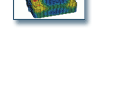 |

Plenary Speakers
|
|

Deformation

 Dislocations
2000:An International
Conference on the Fundamentals of Plastic Deformation, June 19-22, 2000 Dislocations
2000:An International
Conference on the Fundamentals of Plastic Deformation, June 19-22, 2000
Objectives
Predict mechanical response of plastically deformed metals from theoretical
models of the underlying dislocation structures which evolve during deformation.
Problems/Issues/Challenges Addressed
Current finite element simulations of metal forming use empirical models
of mechanical behavior. These models are very inaccurate, increasing
the time and cost of designing dies. Developing new models based
upon the underlying deformation physics requires a new statistical-physics
based theory of deformation, extensive computer simulations of deformation
microstructural changes, and input from recently developed experimental
techniques using NIST's materials science X-ray synchrotron beam lines
at Brookhaven and Argonne.
Deliverables
- A dislocation-based model for changes in mechanical properties during plastic
deformation.
- A computer subroutine called a "materials module" for industrial finite
element method computer codes that are used to model metal forming operations.
Likely Impacts/Consequences
- Accelerate the development of new materials with superior mechanical properties.
- Greatly reduce time and cost of all metal forming operations.
- Enable increased use of Al alloys and high-strength steels in automobiles
resulting in decreased weight and increased fuel economy.
Accomplishments and Highlights
-
Developed initial theoretical model of strain percolation through dislocation
wall structures during plastic deformation of metals. We showed that
a deforming metal is a self-organizing critical system, and have related
the mechanical characteristics to internal parameters of the system.
See Robb Thomson and L. E. Levine, PRL, 81, 3884 (1998).
-
Completed theoretical work on small-angle-scattering (SAS) from dislocation
structures and confirmed model using computer simulations and experimental
measurements. This model allows NIST's unique X-ray synchrotron beam
line to be used for measurements of dislocation structure evolution.
Data from these experiments is now being used as input into the strain
percolation theory and the corresponding computer simulations. Accepted
by Acta Cryst A (Robb Thomson, L. E. Levine, and G. G. Long).
-
Developed a general theory for Bragg scattering by dislocations in crystals
and applied this theory to the specific case of screw dislocations.
This work will allow quantitative parameters to be obtained from future
neutron diffraction experiments to be conducted at the NIST Center for
Neutron Research. See L. E. Levine and Robb Thomson, Acta Cryst,
A53, 590 (1997).
-
The above theoretical work is synergistic with a comprehansive NIST experimental
program being conducted by L. E. Levine, G. G. Long, D. R. Black,
R. J. Fields, and J. Fink.
People
Nist Researchers: L. E. Levine, Robb Thomson
(Emeritus), G. G. Long, R. J. Fields, R. deWit
Industrial Collaborators: O. Richmond,
R. Becker, M. Glazov (ALCOA), B. Maker (LSTC)
Laboratory Collaborators: M. A. Khaleel,
J. S. Vetrano, S. Zhou (LANL)
University Collaborators: J. Hirth, H.
M. Zbib (WSU), G. Daehn (OSU)
|
|






